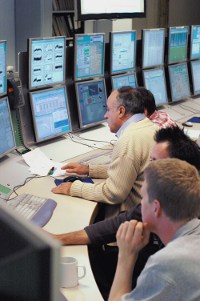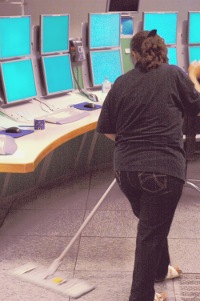 |
 |
|||||||||||||
|
|||||||||||||
|
|||||||||||||
|
The last two weeks were two of the most important (and intense) weeks for accelerator specialists working on the ILC. After a long period of preparation and a series of first tests, they have just finished a period of successfully running the superconducting linear accelerator FLASH at DESY under ILC-like conditions to demonstrate that a long train of electron bunches with high charge can be produced in and travel through the accelerator – and stay there, too. After the ILC-like run, which ended on Monday after long day and night shifts in the control room, FLASH will receive a major upgrade to improve capabilities and performance for the users of the laser light generated by FLASH. The ILC team came with high goals and high demands. “We pushed many operational limits for FLASH,” says co-coordinator John Carwardine from Argonne National Lab, “and we encountered some difficulties – but that meant we learned crucial lessons.” The cavities are supposed to be pushed to the limit of their power to accelerate beams with a current of nine milliamps and 800-microsecond beam pulses. By the end of last week, the beam ran stably with a full 800-microsecond pulse for over ten hours, which meant that the team could commission a new laser that would get them up to their ultimate goal of operating FLASH at 9 milliamperes (mA). In the end they managed several hours of operation at 9mA with short trains (300-500 microseconds) and 2400 bunches at 800 microseconds at 6mA for short periods. A year ago, almost to the day, was the last time the team ran preliminary high-power studies. They made rapid progress towards to final goal – showing that beam phase and energy can be stable, one of the highest-priority goals in the ILC R&D plan – until the studies were cut short by a vacuum event in the beam dump line. Preparations for these latest studies included installing a modified beam dump line that had been fitted with several new diagnostics systems to measure the position of the beam in the dump line and to detect beam losses. One such system, developed at DESY in Zeuthen, uses diamond and sapphire blades to measure beam halo. This is one of a number of improvements that have been made to FLASH for the longest run under ILC-like beam conditions so far. The low-level radiofrequency system (LLRF) was also upgraded and a new laser installed in order to produce three million bunches per second – three times more than last year. The studies at FLASH are a project where ILC machine experts from all three regions have joined together with the local FLASH machine experts at DESY, giving the control room a truly international feel during the shifts. The 9-mA studies are also important demonstrations for FLASH and the European X-Ray Laser project XFEL. FLASH's future programme, for example, also involves running with long bunch trains like the ones driven through its 200-metre tunnel last week. Finding out how much RF power is needed to regulate the beam, another one of the objectives, could have a positive influence on the cost of the ILC. The studies will also help the team prioritise R&D projects for the future. The run ended at 5:35 on Monday morning with almost 25 terabytes of data produced. “The experiment has undoubtedly allowed us to take a major step towards routine long bunch train high-current operation in FLASH, as well as providing important tests and data points for both XFEL and ILC,” says the end-of-run email sent by co-coordinators Nick Walker, John Carwardine and Siggi Schreiber. “After such a run, the only thing to do is to immediately start planning for the next one! We look forward to the future successes of the 9mA collaboration.” -- Barbara Warmbein |
|||||||||||||
| © International Linear Collider |

